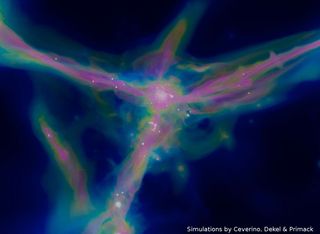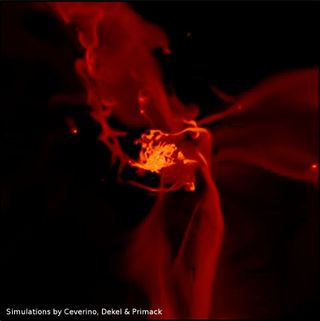Primordial Gas Clouds Reveal Glimpse of Big Bang's Aftermath

This story was updated at 3:19 p.m. EST.
Astronomers have found two clouds of gas that formed in the first few minutes after the Big Bang that created our universe, a new study reveals.
This discovery is the first time these gas clouds have been detected and adds more support to what is already the most widely accepted theory of how our universe came to be, astronomers said.
The primordial gas clouds were found to contain only the lightest elements — hydrogen and helium — that were created in the Big Bang. A few hundred million years later, clumps of these gas clouds condensed to form the first stars, which created and dispersed heavier elements throughout the universe.
The new observations appear to match the theoretical predictions about the chemical makeup of the early universe, said study leader Michele Fumagalli, a graduate student at the University of California, Santa Cruz (UCSC).
"It's actually a very nice confirmation of the theory, because the theory predicts that in the first few minutes after the Big Bang, things like hydrogen and helium were produced and no metals," Fumagalli told SPACE.com. "So, this is the first time that we have a very strong observation and evidence that indeed this theory is correct. It's good news for cosmology."
Heavy metals in the universe
Sign up for the Live Science daily newsletter now
Get the world’s most fascinating discoveries delivered straight to your inbox.
Previously, astronomers had always detected the presence of heavier elements, such as carbon, oxygen, and silicon, throughout the universe. So, finding these "pristine" gas clouds, with their complete lack of heavy metals, was a surprise. [Gallery: History & Structure of the Universe]
"As hard as we've tried to find pristine material in the universe, we have failed until now," study co-author J. Xavier Prochaska, a professor of astronomy and astrophysics at UCSC, said in a statement. "This is the first time we've observed pristine gas uncontaminated by heavier elements from stars."
Fumagalli, Prochaska and study co-author John O'Meara, of Saint Michael's College in Colchester, Vt., detail the study's findings in the Nov. 10 issue of the journal Science.

The researchers discovered the two primordial gas clouds by analyzing the light from distant quasars, which are the brightest objects in the cosmos. Quasars are regions around supermassive black holes where lots of material is being gobbled up, which simultaneously release brilliant light into space.
By looking at distant objects, astronomers are able to see far back in time, because of the time it takes for light to travel across the universe.
The researchers examined the light from quasars using the Keck I Telescope at the W.M. Keck Observatory atop Mauna Kea in Hawaii. The telescope's spectrometer separated the light from the quasars into a spectrum of different wavelengths. This allowed the researchers to examine which wavelengths had been absorbed, which gave them clues about the composition of material that lies between the distant quasar and the telescope on the ground.
"What we do is look in the spectrum for parts that are missing," Fumagalli said. "This is because in between the quasar and us is gas, which is the gas that we want to study. The gas absorbed light at particular frequencies, and by looking at the spectrum, we can try to understand the chemical composition of the gas. In this case, we see that the light is missing at frequencies that are associated with lighter elements, and where we expected to see absorption of heavier metals, we see the light of the quasar unperturbed."
Shaking up the field
Until now, astronomers had predicted that the lowest possible measurement of "metallacity" in the universe is roughly equivalent to less than one-thousandth that of the sun. But, the researchers estimate that these pristine clouds of gas have a metallacity of about one-ten-thousandth that of the sun.
As a result, these findings are challenging previously accepted ideas of how metals are dispersed when they are forged from new stars. [Big Bang to Now in 10 Easy Steps]
"The fact that we see this gas that is untouched shows that the dispersal of metals is not completely homogenous," Fumagalli said. "Metals are formed with stars and released into the universe, but this process doesn't occur the same way everywhere because we see these pockets that are left untouched. It gives us more constraints on how metals are released and how gas is ejected from galaxies where stars are formed."
The researchers' analyses place their observations roughly 2 billion years after the Big Bang, or about 12 billion years ago. According to the Big Bang theory, this time period was when galaxies were growing by pulling in vast streams of cold gas. These theoretical "cold flows" have never been detected, but Fumagalli suggests these primordial gas clouds could be culprits.
To confirm this hypothesis, additional studies will be needed to pinpoint the location of these gas clouds and whether or not they are close to galaxies.
"Using spectra, we can only probe the gas and its composition," Fumagalli said. "We don't know if it's located close to a galaxy. What we're planning to do is now study the environment of this gas to try to understand if it's near a galaxy."
This story was provided by SPACE.com, a sister site to LiveScience. You can follow SPACE.com staff writer Denise Chow on Twitter @denisechow. Follow SPACE.com for the latest in space science and exploration news on Twitter @Spacedotcom and on Facebook.

Denise Chow was the assistant managing editor at Live Science before moving to NBC News as a science reporter, where she focuses on general science and climate change. Before joining the Live Science team in 2013, she spent two years as a staff writer for Space.com, writing about rocket launches and covering NASA's final three space shuttle missions. A Canadian transplant, Denise has a bachelor's degree from the University of Toronto, and a master's degree in journalism from New York University.

